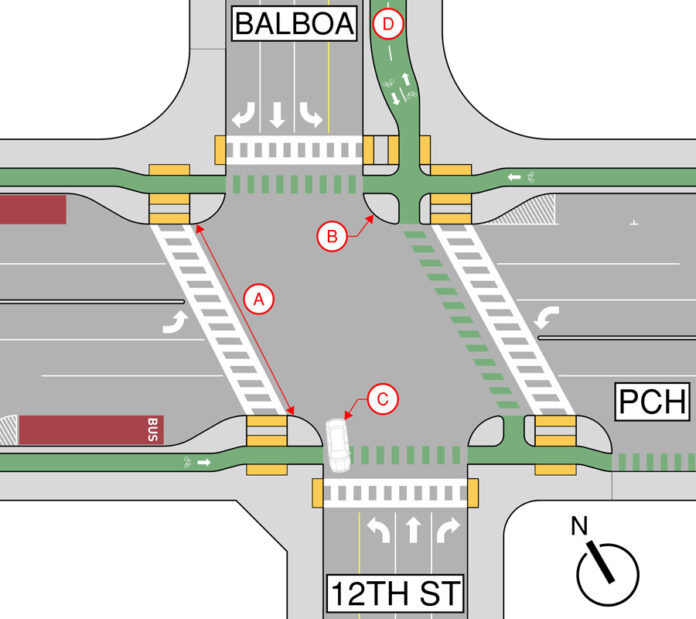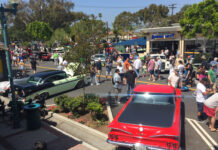By Matthew Terry
No street is perfect, but crossing Pacific Coast Highway as a pedestrian is significantly more dangerous than it should be. This danger is important to recognize because Old Town and The Hill are two pedestrian-oriented communities with points of interest on both sides, making PCH a heavily traversed street by pedestrians.
The typical conversation about how to improve pedestrian safety often puts the onus on the pedestrian or the driver. However, I want to focus on what really bears most of the responsibility: the design of the street itself.
The speed limits of 40/45 mph along the PCH corridor are way too fast for its location. Studies show that speed is a major factor for pedestrian survival in car-related incidents.
Pedestrians have a 20% survival rate when hit by a car going 40 mph, so reducing the speed limit to at least 35 mph would be safer (and quieter) for everyone without having a measurable effect on vehicle throughput.
Whether it’s a narrow one-way street or a wide-open freeway, the design of the street and more specifically, lane widths, dictate the speed limit more than a sign does. This is why most speed limits are derived from studies of how people naturally drive the street.
However, how the street is designed sometimes puts it at odds with its desired speed limit. That’s why it shouldn’t be surprising when cars travel at freeway speeds down PCH when the inside lanes of PCH are 2 feet wider than standard 12-foot wide freeways lanes.
The image accompanying this article of a PCH street section depicts a conceptual idea that I have developed of what a better street could look like.
By modifying the lane widths to what is expected of a 35mph street and reducing the median width, there is then enough space to formalize parallel parking, as well as an opportunity to add protected bike lanes along the entire corridor.
Using the street section as a guide, I have developed a conceptual design of what a better intersection could look like at 12th Street and PCH, shown in the corresponding image to this article. The best way to increase pedestrian safety would be to extend the curbs out to shorten the crossing distance of PCH (callout “A”).
It’s currently 90 feet across, and takes 30 seconds to walk that distance, but with a better design, that distance could be reduced by a third to 60 feet, taking only 20 seconds to cross.
Next, reducing the curb edge radius (callout “B”) would require cars to make right-hand turns at slower speeds to protect people crossing 12th Street and Balboa.
The crosswalks could then be pulled back from the intersection to allow cars to stop for pedestrians without blocking traffic along PCH and give drivers a better view of possible pedestrians in the crosswalk (callout “C”).
For traffic signal sequencing, implementing a system similar to the intersection at Seal Beach Boulevard and PCH, where one side goes and then the other would better protect pedestrians and make it easier for cars to move through the intersection.
Finally, I think it’s important that we work towards creating a network of protected bike lanes linking up with McGaugh to provide kids with a safe, dedicated route to school (callout ‘D’).
With that said, I do recognize that PCH is controlled by Caltrans, so the city does not have much say in this conversation.
In a presentation at a recent City Hall meeting regarding the work they are currently performing along PCH, Caltrans has stated that the only improvements to intersections will be the addition of ladder crosswalks in areas that don’t currently have one.
Ladder crosswalks are a superficial measure that do not improve pedestrian safety and are already implemented on half of the intersections along PCH in Seal Beach.
The city needs to make it very clear to Caltrans that it is not doing enough and that there is a desire to do better.
Additionally, the city must make it very clear to state lawmakers that the city should have a larger say over the PCH corridor.
SB 960 does present an opportunity for positive change as it’s a proposed bill that would direct Caltrans to design streets for everyone and not just cars.
I know some may recoil at the sound of all this because of the possible effect it may have on cars, but what we have now is not ideal.
Pedestrian deaths are currently at a national 40-year high, and PCH is fundamentally no different than any other street in the nation and it’s only a matter of time until the next tragedy strikes. Knowing this, we must do everything we can to make PCH and the intersections along its corridor safer for everyone and prioritize safety over throughput.
Matthew Terry is a Seal Beach resident and member of the Citizen-Council Parking Advisory Ad Hoc Committee.












